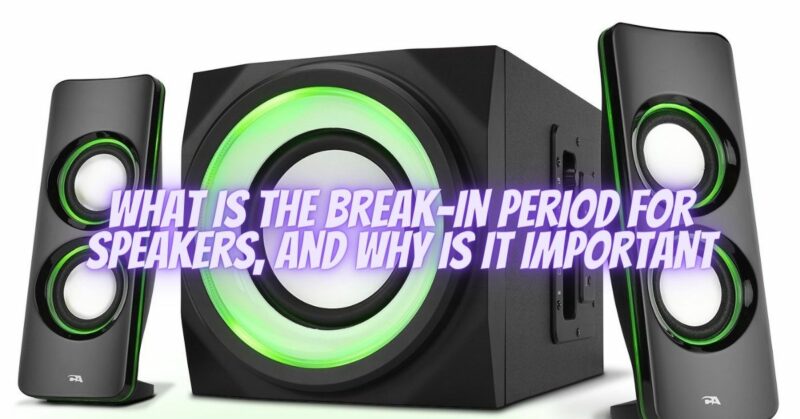When you purchase a new set of speakers, you may encounter the term “break-in period” or “speaker burn-in.” This refers to the recommended period during which speakers need to be used before they reach their optimal performance level. While opinions vary on the exact duration and significance of this period, understanding the concept and potential benefits of a break-in period can help you make informed decisions and maximize the performance of your speakers. In this article, we will explore the break-in period for speakers, its importance, and its potential impact on audio quality.
Understanding the Break-In Period:
The break-in period, also known as speaker burn-in or run-in, refers to the period of time during which new speakers are gradually exercised to optimize their performance. This process involves playing audio through the speakers at normal listening levels for a recommended duration. The purpose of the break-in period is to allow the components within the speaker to settle and adapt to their operating conditions, potentially improving audio quality over time.
Importance of the Break-In Period:
The break-in period is important for several reasons:
- Component Flexibility: New speakers often have stiff suspension systems, including the speaker cones, surrounds, and voice coils. The break-in period helps these components become more flexible and responsive, allowing for better control and accuracy in sound reproduction.
- Even Frequency Response: During the break-in period, speakers may experience changes in frequency response as the components loosen and settle. The break-in process aims to reduce any initial frequency imbalances, resulting in a more consistent and even frequency response across the audio spectrum.
- Improved Dynamics and Detail: As speakers undergo the break-in period, the movement and flexibility of their components can improve. This can lead to enhanced dynamics, transient response, and detail retrieval, allowing for a more engaging and realistic sound reproduction.
- Reduced Mechanical Distortion: Speaker drivers, especially those with moving parts like cones and voice coils, can exhibit mechanical distortion when new. The break-in period helps reduce this distortion by allowing the components to loosen up and operate more smoothly, resulting in cleaner and more accurate audio reproduction.
- Longevity and Stability: Adequate break-in can potentially enhance the long-term reliability and stability of speakers. Exercising the components within their designed range from the early stages helps ensure that they perform optimally and remain reliable over extended periods.
Factors Influencing the Break-In Period:
The duration and impact of the break-in period can vary depending on several factors:
- Speaker Design and Construction: Different speaker designs, materials, and construction techniques can influence the break-in period. Factors such as the stiffness of the speaker components, the materials used, and the complexity of the driver designs can all play a role.
- Speaker Type: Different types of speakers, such as dynamic drivers, electrostatic speakers, or planar magnetic speakers, may have varying break-in characteristics. Consult the manufacturer’s guidelines or recommendations specific to your speaker type.
- Listening Levels and Duration: The recommended break-in period typically involves playing audio through the speakers at normal listening levels for a certain duration. The exact duration can range from a few hours to several days or weeks. Consult the manufacturer’s guidelines or recommendations for specific instructions.
Conclusion:
The break-in period for speakers allows the components to settle and adapt to their operating conditions, potentially enhancing audio quality over time. While the exact duration and significance of the break-in period may vary depending on factors such as speaker design, construction, and type, taking the time to properly break in your speakers can help achieve their optimal performance. By following manufacturer recommendations and gradually exercising your speakers, you can potentially unlock improvements in frequency response, dynamics, detail retrieval, and overall audio quality. Remember to consult the manufacturer’s guidelines for specific instructions regarding the break-in process for your speakers.


